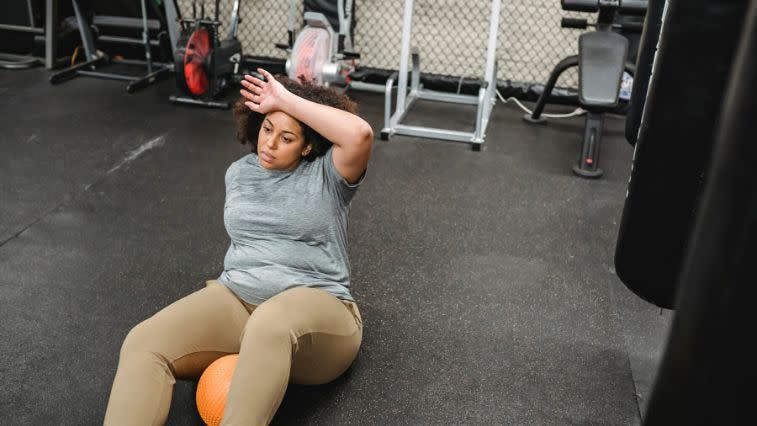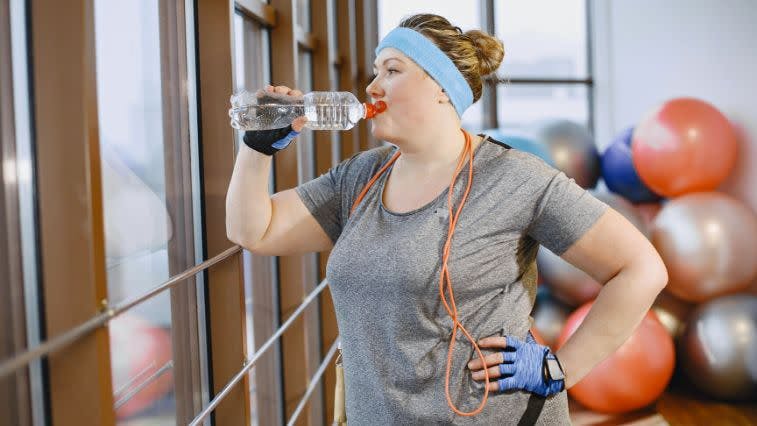Sweating and Weight Loss: Is There a Link?
Our content strives to support, inform, and motivate you to meet your health goals. We want to be your trusted source of expert- and science-backed info dispensed in simple, actionable ways. Read our Editorial Guidelines.
You work out. You sweat. Heck, you sweat profusely. You may feel “lighter.” Does this mean you’re losing weight?
Simple answer: Yes.
But, the weight you lost is “water weight” and you’ll gain it back once you rehydrate. No, this doesn’t mean you should delay drinking water after your workout.
What weight should you focus on losing, and how? Four fitness experts share their insights on sweating and whether it can help you lose weight.
The Sweat-Weight Loss Connection
Sweating is your body’s way of cooling down when it heats up, whether you’re sick, in a sauna, or exercising. During exercise, your muscles heat up more, and you’re likely to sweat more.
“The more you work out, the more you sweat. How much you sweat doesn't necessarily depend on how hard you work out. It can also depend on genetics, environment, and hydration levels. So, sweating means your body is working hard, but it's not the only measure of your workout intensity,” says Jeremiah Daniel, a level 4 trainer, CEO and Founder of Moonlight Reviews.
Sweat mainly contains water. It also contains electrolytes: sodium, magnesium, calcium, and potassium. So, while you can technically lose weight when you sweat, there’s a catch. When you drink more water, the water weight you lost returns.
“Your body is not metabolizing fat or truly losing weight [when you sweat]. All that’s happening is that large quantities of water are being sweated out under extreme circumstances [and that] manipulates the number on the scale,” explains Daniel.
How Do You Know if You Lost Water Weight or Body Fat?

To lose body fat, you must burn through (or metabolize) your fat stores.
“This happens when energy output is increased and calorie intake is not increased to match. It also happens when calorie intake is decreased with physical output staying the same. If calorie output is greater than calorie input, your body uses its saved stores as energy to function. That’s what happens when fat is burned and is how you lose weight,” says Kealan Bailey, founding trainer at Rumble Boxing.
The burned fat leaves your body as carbon dioxide, sweat, and urine, says Martin Sharp, a fitness expert at Sharp Fit for Life. While you may want to lose this fat on a specific body part first, there is no set pattern for fat loss.
“Some people may notice that their stomach is the first to slim down. Others may notice that their thighs or arms shrink first,” explains Daniel.
The only way to know for sure that you’ve lost body fat is to test your body fat percentage. William Toro, a personal trainer and rehab physiotherapist at Welcyon suggests doing an InBody scan. It allows you to measure your fat, muscle, and water levels accurately.
Not everyone has access to or can afford a scan like this, though, but it’s also possible to use a caliper to measure your body fat. Take measurements from your waist, upper arm, top of your thigh, chest, and upper back (get a friend to help!) at the start of your weight loss journey and about every two weeks to check your progress.
Safe & Sustainable Weight Loss (Sweaty or Not)
Just like sweating doesn’t burn fat, it also doesn’t burn calories. “The calorie burn happens during the physical activity that makes you sweat. If you want to burn calories, engage in physical activities that increase your heart rate: running, cycling, or strength training,” says Daniel, who works with clients who have unique challenges and fitness goals.
His clients often ask him how much weight they can lose in a month. The amount depends on your starting weight, body composition, and overall health, Daniel tells them.
“A healthy and sustainable weight loss rate is 1–2 pounds per week or 4–8 pounds monthly, depending on the above factors. This is a general guideline; some people may lose more or less weight depending on their circumstances,” continues Daniel.
Consistent practice of healthy habits over the long run reaps rewards for Bailey’s clients.
“A client going from a sedentary lifestyle to an active one that includes calorie management of some kind could see significant weight loss in a month. One who’s working on that ‘last 5 pounds’ and is already active and managing their calories might take longer to lose weight,” she explains.
According to the CDC, losing 1–2 pounds a week allows you to lose weight steadily and sustainably. This way, your chances of keeping it off are higher.
As you work toward steadily and gradually losing weight, rehydrate and replenish the water and electrolytes you lose through sweat. Electrolytes regulate nerve and muscle function and help rebuild damaged tissue. If you feel weak, this could be a sign that your body may be low on electrolytes. This affects your performance and, ultimately, your ability to reach your weight loss goals.
“Drink water before, during, and after working,” advises Daniel.
Read more: How Much Water to Drink in a Day: Tips From an RD

If you’re working out for longer periods and the weather is warm and humid, you may want to try an electrolyte drink powder or tablets that dissolve in water. Read ingredient labels and watch out for too much added sugars or sweeteners. Low-sugar brands you can try: Nuun, LMNT, UCAN, and Key Nutrients.
Hot Tips From Weight Loss Experts
Follow these expert weight loss tips to kick off your weight loss journey:
Train for success: Strength training and cardio will help you burn calories and fat, build muscle, and increase your resting metabolic rate — that’s how many calories you burn at rest. Sharp recommends at least two full-body strength sessions per week plus low-intensity, steady-state cardio — that’s movement that raises your heart rate but not so high that you can’t talk to a workout buddy.
Have fun: Don't take workouts too seriously. And remember that exercise can be social (a hike with friends), relaxing (a bike ride by the beach), and inventive (chasing your kids or dog in the park). Enjoy the process, and remember that progress is more important than perfection.
Add some music: A good workout soundtrack can make the sweat worth it!
Prioritize sleep: It’s important to sweat, but getting enough quality sleep each night is vital for workout recovery, proper hormone function, and a brain break. Not sleeping enough or well may increase cravings and encourage you to eat more than you need.
Clean up your diet: “Eat foods rich in protein, fiber, and healthy fats, while limiting processed foods and added sugars,” advises Bailey.
One Final Note
You can’t judge how effective your workout was by how much you sweat. The key to weight loss is practicing consistent habits over time, and that includes workouts.
“One huge sweaty workout a week for a month isn’t going to get you the same results as three average workouts per week for six months or a year,” says Bailey. “The best thing you can do to achieve your weight loss goals is: start with one dietary modification you can commit to, start with a manageable exercise routine, and then add on from there as these become habits.”
If you need help losing weight — particularly excess body fat — sign up for a free consultation with a certified personal trainer.